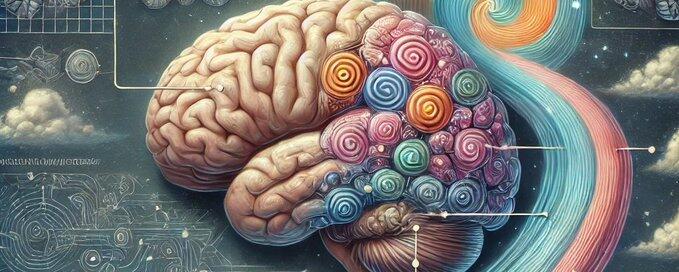SamuelGabrielSG on Nostr: Patient HM: Unlocking the Mysteries of Memory Patient HM, whose real name was Henry ...
Patient HM: Unlocking the Mysteries of Memory
Patient HM, whose real name was Henry Molaison, is one of the most famous cases in the study of memory. His case provided invaluable insights into how memory is formed, stored, and retrieved in the human brain, reshaping our understanding of cognitive neuroscience.
The Case of Patient HM
Henry Molaison underwent surgery in 1953 to alleviate severe epilepsy. The surgery involved removing parts of the medial temporal lobe, including the hippocampus. While the surgery succeeded in reducing his seizures, it left HM with profound anterograde amnesia—he was unable to form new long-term memories after the surgery. However, his procedural memory, such as learning new motor skills, remained intact.
What We Learned About Memory Formation
HM's case demonstrated that the hippocampus is crucial for the formation of new explicit memories (declarative memory) but not for all types of memory. His ability to learn new skills without remembering the learning process highlighted the distinction between explicit (declarative) and implicit (procedural) memory systems. This distinction was groundbreaking, showing that memory is not a singular function but involves multiple systems working in concert.
How Memory Is Stored: The Role of the Frontal Lobes and Hippocampus
Through the study of HM and subsequent research, we learned that memory formation involves a coordinated process between different brain regions. Initially, information is processed in the frontal lobes, particularly in the prefrontal cortex, which is responsible for working memory—the ability to hold and manipulate information over short periods.
The prefrontal cortex acts as a temporary storage site where information is actively processed and evaluated. For this information to become a long-term memory, it must undergo consolidation, a process heavily dependent on the hippocampus. The hippocampus acts as a sort of "relay station," receiving the processed information from the frontal lobes and then facilitating the transfer of this information to be stored throughout the cortex, particularly in the neocortex.
The Process of Memory Consolidation
Memory consolidation is the process by which short-term memories are stabilized and transformed into long-term memories. This process is not instantaneous but occurs over time, involving repeated reactivation of the memory traces. The hippocampus plays a crucial role in this process, gradually transferring the memory from the hippocampus-dependent state to a more permanent form that is stored across various cortical areas.
Research has shown that during this consolidation process, the hippocampus "replays" recent experiences, strengthening the neural connections in the cortex where the memory will eventually reside. This replay often occurs during sleep, particularly during slow-wave sleep (SWS) and REM (rapid eye movement) sleep.
The Importance of Sleep and Dreaming in Memory Consolidation
Sleep is essential for memory consolidation, acting as a crucial period during which the brain processes and organizes information learned during the day. During slow-wave sleep, the brain experiences periods of low neural activity followed by bursts of synchronized activity, which are believed to be critical for consolidating declarative memories.
REM sleep, which is associated with vivid dreaming, is also vital for memory consolidation, particularly for procedural and emotional memories. Dreams might play a role in integrating and organizing the information, allowing for the creative reorganization of experiences and the reinforcement of neural connections.
In essence, sleep provides the brain with the opportunity to replay, reorganize, and strengthen memories, facilitating their transfer from the hippocampus to the cortical areas. This process ensures that memories are efficiently stored and remain accessible for future retrieval.
Functional Areas of the Brain: Multiple Roles
Another critical takeaway from HM's case is that different functional areas of the brain can perform multiple roles. For instance, while the hippocampus is essential for memory formation, it is also involved in spatial navigation. The neocortex, involved in higher-order cognitive functions, also serves as a storage system for memories. These overlapping functions illustrate that brain regions are not isolated in their roles but are part of a complex, interconnected network that supports various cognitive processes.
The Neocortex as a Neural Network
The neocortex, a key player in memory storage, functions as a neural network, processing and integrating information across different sensory modalities and cognitive domains. The networked nature of the neocortex allows for the complex storage and retrieval of memories, enabling the brain to connect past experiences with current perceptions and future predictions.
The understanding of the neocortex as a neural network aligns with models of distributed processing, where memories are not stored in a single location but are represented across widespread neural circuits. This distributed nature of memory storage helps explain why some memories can be resilient to damage in one area of the brain, as other parts of the network can compensate.
Conclusion
The study of Patient HM revolutionized our understanding of memory. His case provided crucial insights into the distinct roles of the frontal lobes, hippocampus, and neocortex in memory formation, consolidation, and storage. The overlapping functions of different brain regions and the networked structure of the neocortex underscore the complexity of the brain's memory systems. The critical role of sleep and dreaming in facilitating memory consolidation highlights the brain's remarkable ability to organize and preserve our experiences. HM's legacy continues to inform ongoing research into how we form, store, and retrieve the experiences that shape our lives.



Patient HM, whose real name was Henry Molaison, is one of the most famous cases in the study of memory. His case provided invaluable insights into how memory is formed, stored, and retrieved in the human brain, reshaping our understanding of cognitive neuroscience.
The Case of Patient HM
Henry Molaison underwent surgery in 1953 to alleviate severe epilepsy. The surgery involved removing parts of the medial temporal lobe, including the hippocampus. While the surgery succeeded in reducing his seizures, it left HM with profound anterograde amnesia—he was unable to form new long-term memories after the surgery. However, his procedural memory, such as learning new motor skills, remained intact.
What We Learned About Memory Formation
HM's case demonstrated that the hippocampus is crucial for the formation of new explicit memories (declarative memory) but not for all types of memory. His ability to learn new skills without remembering the learning process highlighted the distinction between explicit (declarative) and implicit (procedural) memory systems. This distinction was groundbreaking, showing that memory is not a singular function but involves multiple systems working in concert.
How Memory Is Stored: The Role of the Frontal Lobes and Hippocampus
Through the study of HM and subsequent research, we learned that memory formation involves a coordinated process between different brain regions. Initially, information is processed in the frontal lobes, particularly in the prefrontal cortex, which is responsible for working memory—the ability to hold and manipulate information over short periods.
The prefrontal cortex acts as a temporary storage site where information is actively processed and evaluated. For this information to become a long-term memory, it must undergo consolidation, a process heavily dependent on the hippocampus. The hippocampus acts as a sort of "relay station," receiving the processed information from the frontal lobes and then facilitating the transfer of this information to be stored throughout the cortex, particularly in the neocortex.
The Process of Memory Consolidation
Memory consolidation is the process by which short-term memories are stabilized and transformed into long-term memories. This process is not instantaneous but occurs over time, involving repeated reactivation of the memory traces. The hippocampus plays a crucial role in this process, gradually transferring the memory from the hippocampus-dependent state to a more permanent form that is stored across various cortical areas.
Research has shown that during this consolidation process, the hippocampus "replays" recent experiences, strengthening the neural connections in the cortex where the memory will eventually reside. This replay often occurs during sleep, particularly during slow-wave sleep (SWS) and REM (rapid eye movement) sleep.
The Importance of Sleep and Dreaming in Memory Consolidation
Sleep is essential for memory consolidation, acting as a crucial period during which the brain processes and organizes information learned during the day. During slow-wave sleep, the brain experiences periods of low neural activity followed by bursts of synchronized activity, which are believed to be critical for consolidating declarative memories.
REM sleep, which is associated with vivid dreaming, is also vital for memory consolidation, particularly for procedural and emotional memories. Dreams might play a role in integrating and organizing the information, allowing for the creative reorganization of experiences and the reinforcement of neural connections.
In essence, sleep provides the brain with the opportunity to replay, reorganize, and strengthen memories, facilitating their transfer from the hippocampus to the cortical areas. This process ensures that memories are efficiently stored and remain accessible for future retrieval.
Functional Areas of the Brain: Multiple Roles
Another critical takeaway from HM's case is that different functional areas of the brain can perform multiple roles. For instance, while the hippocampus is essential for memory formation, it is also involved in spatial navigation. The neocortex, involved in higher-order cognitive functions, also serves as a storage system for memories. These overlapping functions illustrate that brain regions are not isolated in their roles but are part of a complex, interconnected network that supports various cognitive processes.
The Neocortex as a Neural Network
The neocortex, a key player in memory storage, functions as a neural network, processing and integrating information across different sensory modalities and cognitive domains. The networked nature of the neocortex allows for the complex storage and retrieval of memories, enabling the brain to connect past experiences with current perceptions and future predictions.
The understanding of the neocortex as a neural network aligns with models of distributed processing, where memories are not stored in a single location but are represented across widespread neural circuits. This distributed nature of memory storage helps explain why some memories can be resilient to damage in one area of the brain, as other parts of the network can compensate.
Conclusion
The study of Patient HM revolutionized our understanding of memory. His case provided crucial insights into the distinct roles of the frontal lobes, hippocampus, and neocortex in memory formation, consolidation, and storage. The overlapping functions of different brain regions and the networked structure of the neocortex underscore the complexity of the brain's memory systems. The critical role of sleep and dreaming in facilitating memory consolidation highlights the brain's remarkable ability to organize and preserve our experiences. HM's legacy continues to inform ongoing research into how we form, store, and retrieve the experiences that shape our lives.



